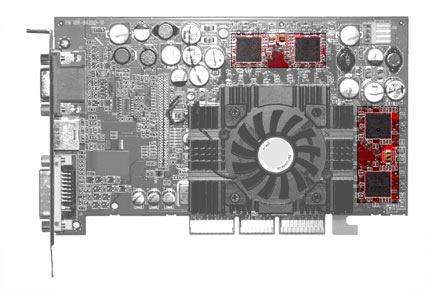How Much RAM Does Your Graphics Card Really Need?
RAM Bandwidth Versus Quantity
The biggest misconception out there is that more graphics RAM will increase gaming performance. But, for the most part, this is untrue. While the bandwidth of the graphics RAM might have a direct effect on gaming performance, the quantity of RAM doesn't have a direct impact on how fast a graphics card performs. The quantity of RAM does have an indirect impact on performance sometimes, and we'll talk about this in a little bit.
The bandwidth of graphics card RAM is affected by two main factors: the clock rate and interface width. Clock rate is measured in MHz, just like a CPU. The width of an interface is measured in bits, such as 128-bits wide. Without going into too much detail, you should know that 200 MHz memory should provide twice the bandwidth of 100 MHz memory, assuming everything else is equal. Similarly, a 128-bit memory bus should provide twice the bandwidth of a 64-bit bus.
It gets a little complicated because we're talking about two variables here: clock rates and bandwidth. For example, 200 MHz, 64-bit memory should offer approximately the same bandwidth as 100 MHz, 128-bit memory. There are other factors, such as memory latency. Technology also plays a role, as GDDR5 offers twice the throughput of DDR through GDDR4 at a given clock speed. But, for the most part, all you have to remember is that more bandwidth should have a direct impact on your gaming performance.
However, we won't look too hard at memory bandwidth today. Instead, the quantity of graphics card RAM is what we'll focus on, which is measured in megabytes (MB) or gigabytes (GB).
As we've said, the quantity of RAM that the graphics card employs doesn't have a direct impact on game performance, but it can have an indirect impact. Graphics card RAM will only negatively affect performance if there isn't enough to handle what a specific game title requires. The point is that all other factors being equal, a graphics card with 2GB (2,048 MB) should perform exactly the same as a graphics card with 512MB as long as the game's graphics memory requirements are below 512MB. If the game's settings and resolution require more than 512MB of graphics card RAM, the 512MB card will demonstrate a performance penalty compared to the 2GB card.
With this in mind, we're going to see exactly what happens when we test a number of popular games at different settings and resolutions with three different graphics cards armed with 512MB, 1GB, and 2GB of RAM. All of these models center on ATI's Radeon HD 4870 GPU, and we will make sure they are set to the same clock speeds so that the bandwidth and engine throughput are identical. Let's have a quick look at the cards.
Current page: RAM Bandwidth Versus Quantity
Prev Page Introduction Next Page Three Radeon HD 4870s: 512MB, 1GB, And 2GBGet Tom's Hardware's best news and in-depth reviews, straight to your inbox.
Don Woligroski was a former senior hardware editor for Tom's Hardware. He has covered a wide range of PC hardware topics, including CPUs, GPUs, system building, and emerging technologies.
-
radiowars Great article guys. I've debated this many times with friends- good to see a definite result. Heh, GTX 275 w/ 896 works well @ 1680x1050 for me. I doubt I'd need anything higher than that for my resolution.Reply -
burnley14 I really like the alternating images you use in these articles, they are very helpful and make it much easier to compare the various detail settings.Reply
Also, great article overall. Keep up the good work! -
cleeve Thanks burnley, animated GIFs are a bit of a pain to make, but it's nice to know they're appreciated. :)Reply -
blueer03 This was very interesting. But I would like to see the performance difference from a mid-stream (say a 4850) as compared to a high end video card. Would it have made sense to spring for the 1GB 4850, or would there be no difference because of the cards inherent limitations? And the same thing with the lower level cards. At what point in the hierarchy of video cards does springing for more than the reference memory levels make sense?Reply -
cleeve With lower end cards you'd see the same effect, but with the lower frame-rates that those cards would produce. The end result is the same: one they run out of RAM at a certain setting, the performance will suffer, but until then it's the same across the board.Reply -
cleeve knutjbHow much ram will the 5870 eyefinity version need?Reply
Depends on the resolution and settings just like everything else. but it's a good question, if there's enough interest in this article I'll look into that in the future. -
liquidsnake718 Im surprised that Crysis doesnt utilize all the RAM(even for an older title) for distance similarly to titles like GTA. Im sure the new Crytek engine will make use of Ram so we can see even buildings and huge alien robots further in the distance with vivid details.Reply
We can only look forward to a more intense and visually stunning Crysis 2 as I can only imagine how the story would progress and end up being in space. I can imagine huge asteroids looking as real coming at the player using nvidias 3d vision and utilizing AA in order to make it apparent from a distance.
Think Halo style world but with unrivaled graphics and a more realistic feel with DX11. -
Arkz il tell ya whats a bitch, i have a 1920x1080 monitor, nice? yes. I have an 8800GT too.. nice? kinda.. its the 256MB version.. so.. if i wanna turn up the sexiness i get baaaad fpsReply

